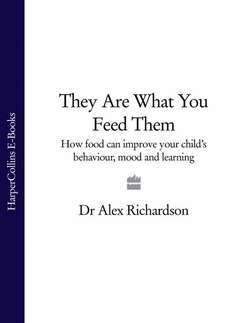Читать книгу They Are What You Feed Them: How Food Can Improve Your Child’s Behaviour, Mood and Learning - Dr Richardson Alex - Страница 45
Overlaps
ОглавлениеAlthough they’re usually regarded as separate conditions, in practice there’s a big overlap between dyslexia, dyspraxia, ADHD and the autistic spectrum. Most children who qualify for one of these labels also show features of one or more of the others.
30-50 per cent of dyslexic and ADHD children have clear dyspraxic tendencies.
30-50 per cent of dyspraxic children have notable dyslexic difficulties.
Attentional and working memory problems are found in all three conditions.
Always remember that your child is an individual. Reality is much messier than any of the discrete diagnostic labels we may use to ‘pigeon-hole’ children, so even if your child has one diagnosis already, be aware that this may not give the whole picture.
This is a summary of a letter I received from Jane, a grateful parent:
‘As a baby, when Peter started on solid food he became tearful and wakeful, began to projectile vomit and lost weight dramatically. He developed a high temperature and a red rash so bad they thought it was scarlet fever! In fact, he reacted badly to many foods including eggs, wheat, artificial food colourings and other additives. When he started school, teachers said he was hyperactive – but with advice from the Hyperactive Children’s Support Group we modified his diet, and Peter improved dramatically.
All was fine until he started falling behind at school, and this time (aged 10) he was diagnosed as dyslexic. I heard about your research and increased his omega-3 fatty acid intake. This seemed to do wonders, and he quickly became an above-average pupil.
Then at 15, Peter started using cannabis, which he reacted to badly. Within a year he was admitted to an adult psychiatric ward and was prescribed powerful drugs (even though he still had easy access to cannabis in the hospital!). His prognosis was said to be poor. The hospital diet contained lots of foods I knew didn’t suit Peter, and I explained his history of food allergies, but they wouldn’t listen. The doctors just decided he had ‘‘mental health problems’’. At no time was his physical health investigated.
Then I attended an inspiring conference on diet and behaviour. With specialist help, I was able to persuade the hospital staff to put Peter onto a new dietary regime. This made such a difference – and once he himself could understand what had happened to him, he agreed to stop smoking cannabis. Within four weeks he went from being a seriously ill young man to near normal.
Six months later, Peter was back at college and enjoying a social life with family and friends. Without the help of researchers and scientists, I really think Peter would still be a lost child in an adult ward. Thanks to them, I have my son back – the greatest gift anyone could have given me.’
